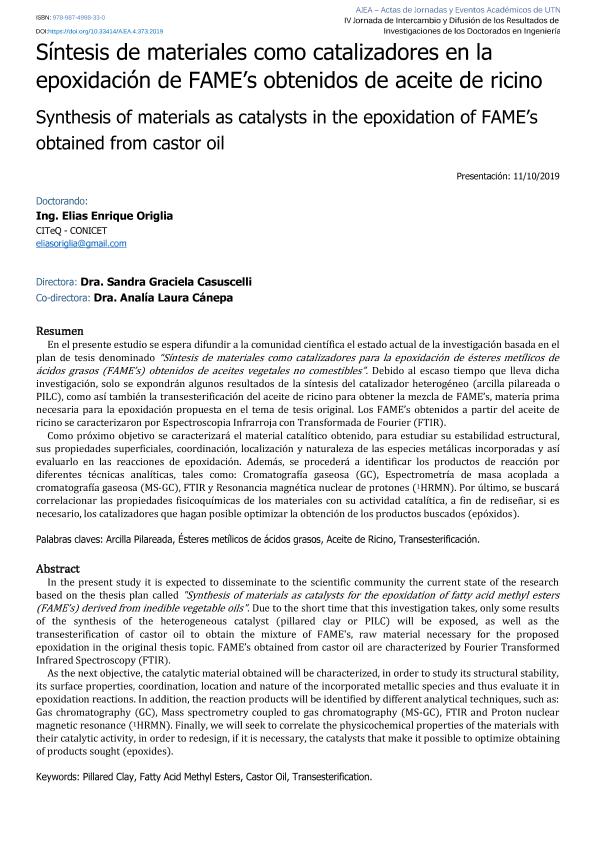Evento
En el presente estudio se espera difundir a la comunidad científica el estado actual de la investigación basada en el plan de tesis denominado "Síntesis de materiales como catalizadores para la epoxidación de ésteres metílicos de ácidos grasos (FAME´s) obtenidos de aceites vegetales no comestibles". Debido al escaso tiempo que lleva dicha investigación, solo se expondrán algunos resultados de la síntesis del catalizador heterogéneo (arcilla pilareada o PILC), como así también la transesterificación del aceite de ricino para obtener la mezcla de FAME´s, materia prima necesaria para la epoxidación propuesta en el tema de tesis original. Los FAME´s obtenidos a partir del aceite de ricino se caracterizaron por Espectroscopia Infrarroja con Transformada de Fourier (FTIR). Como próximo objetivo se caracterizará el material catalítico obtenido, para estudiar su estabilidad estructural, sus propiedades superficiales, coordinación, localización y naturaleza de las especies metálicas incorporadas y así evaluarlo en las reacciones de epoxidación. Además, se procederá a identificar los productos de reacción por diferentes técnicas analíticas, tales como: Cromatografía gaseosa (GC), Espectrometría de masa acoplada a cromatografía gaseosa (MS-GC), FTIR y Resonancia magnética nuclear de protones (1HRMN). Por último, se buscará correlacionar las propiedades fisicoquímicas de los materiales con su actividad catalítica, a fin de rediseñar, si es necesario, los catalizadores que hagan posible optimizar la obtención de los productos buscados (epóxidos). In the present study it is expected to disseminate to the scientific community the current state of the research based on the thesis plan called "Synthesis of materials as catalysts for the epoxidation of fatty acid methyl esters (FAME’s) derived from inedible vegetable oils". Due to the short time that this investigation takes, only some results of the synthesis of the heterogeneous catalyst (pillared clay or PILC) will be exposed, as well as the transesterification of castor oil to obtain the mixture of FAME's, raw material necessary for the proposed epoxidation in the original thesis topic. FAME’s obtained from castor oil arecharacterized by Fourier Transformed Infrared Spectroscopy (FTIR).As the next objective, the catalytic material obtained will be characterized, in order to study its structural stability, its surface properties, coordination, location and nature of the incorporated metallic species and thus evaluate it in epoxidation reactions. In addition, the reaction products will be identified by different analytical techniques, such as: Gas chromatography (GC), Mass spectrometry coupled to gas chromatography (MS-GC), FTIR and Proton nuclear magnetic resonance (1HRMN). Finally, we will seek to correlate the physicochemical properties of the materials with their catalytic activity, in order to redesign, if itis necessary, the catalysts that make it possible to optimize obtaining of products sought (epoxides).
Síntesis de materiales como catalizadores en la epoxidación de FAME´s obtenidos de aceite de ricino
Título:
Synthesis of materials as catalysts in the epoxidation of FAME’s obtained from castor oil
Colaboradores:
Marciszack, Marcelo Martín; Anunziata, Oscar Alfredo

Tipo del evento:
Jornada
Nombre del evento:
IV Jornada de Intercambio y Difusión de los Resultados de Investigaciones de los Doctorados en Ingeniería
Fecha del evento:
22/11/2019
Institución Organizadora:
Universidad Tecnológica Nacional;
Título del Libro:
Actas de IV Jornada de Intercambio y Difusión de los Resultados de Investigaciones de los Doctorados en Ingeniería
Editorial:
Universidad Tecnológica Nacional
ISBN:
978-987-4998-33-0
Idioma:
Español
Clasificación temática:
Resumen
Archivos asociados
Licencia
Identificadores
Colecciones
Eventos(CITEQ)
Eventos de CENTRO DE INVESTIGACION Y TECNOLOGIA QUIMICA
Eventos de CENTRO DE INVESTIGACION Y TECNOLOGIA QUIMICA
Citación
Síntesis de materiales como catalizadores en la epoxidación de FAME´s obtenidos de aceite de ricino; IV Jornada de Intercambio y Difusión de los Resultados de Investigaciones de los Doctorados en Ingeniería; Córdoba; Argentina; 2019; 71-75
Compartir
Altmétricas



